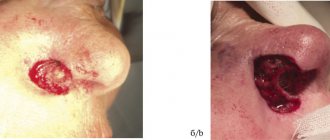A. A. Hmayakyan Dental surgeon, implantologist
Today, implantation surgeons rarely do without mucoplasty. This is a very important component of implantological rehabilitation, since high-quality soft tissues ensure patient comfort and a favorable treatment prognosis, both functionally and aesthetically.
There are patients (for example, with a thick mucosal biotype) for whom additional work with soft tissues is not indicated. In such situations, it is possible to achieve high-quality tissue volume around the implant without any plastic surgery. And there are those for whom work with soft tissues is indicated, consisting of several phases at different stages of treatment.
When is soft tissue plastic surgery necessary?
- Deficiency of soft tissue volume, as a result:
- long-term absence of a tooth (with edentia, atrophy occurs both in bone tissue and soft tissues);
- wearing a Maryland prosthesis (mechanical impact on soft tissues, even in a short period of time, leads to a loss of gum volume);
- thin biotype of the mucosa (here we are talking about the prognosis of future restoration and prevention of volume deficit of hard and soft tissues).
- Lack of attached keratinized mucosa due to:
- the need for directed bone regeneration or an already performed GBR operation (the suturing technique afterward is such that part of the keratinized mucosa is often lost, not counting the already existing atrophy);
- past mistakes during implantation or soft tissue plastic surgery.
- In order to improve the prognosis of treatment. Creating a reserve of soft tissue in the frontal region increases the favorable prognosis of treatment.
To achieve success, it is necessary to comply with parameters that must be taken into account at the planning stage. Some factors may influence directly, others indirectly. Factors such as the accuracy of sampling the SDT or SST, the processing method, the quality of the graft, the preparation of the material fixation zone and the quality adaptation to the receiving bed directly influence.
Indirect ones include careful planning and compliance with the surgical protocol (position, inclination and size of implants, correct choice of suprastructures, compliance with the necessary timing and stages of treatment).
Before we go any further, let's refresh our memory a little. The purpose of dental implantation is to restore a functionally and aesthetically missing element of the dental system. In the dental system, we are interested in bone tissue, mucous membranes, and adjacent teeth. The function of bone tissue is support, retention of the implant, perception and distribution of load. The function of the mucosa is to protect and nourish bone tissue and ensure adequate hygiene.
Based on the above, it turns out that for high-quality implant treatment it is necessary to have high-quality bone tissue in the right volume and the right place (if there is not enough, create it), and high-quality soft tissue (not only in volume, but also of the desired histological structure). Below are examples in different clinical situations.
Progress of surgery
The clear sequence of actions in the process of bone grafting during dental implantation completely depends on the type of surgical procedure. The average plan of action for a dental surgeon is as follows:
- Providing access to the operated area of the gums of the upper or lower jaw (alveolar process);
- Preparation of the bone bed for graft installation;
- Fixing the bone block, immersing it in tissue or placing special shavings (depending on the type of bone grafting);
- Installation of barrier membranes (not required everywhere);
- Suturing soft tissues.
This is followed by the process of graft engraftment and the formation of one’s own bone tissue, which lasts about six months. Healing times depend on the grafts used, the amount of bone grafting and the type of surgery. Transplants are of the following types:
- Own bone tissue taken from certain areas of the body (autograft);
- Human bone tissue taken from cadavers (allograft);
- Bone tissue of animal origin (xenograft);
- Artificial bone tissue (alloplant).
Each of the listed options has its own advantages and disadvantages, so they are all widely used in modern dentistry. An autograft implanted into spongy gum tissue full of blood vessels and biologically active substances takes root best.
Clinical case No. 1
Simple implantation for long-term missing teeth. An implant is installed, GTR (guided tissue regeneration) is carried out using a SST (connective tissue graft), and a FDM (gingival cuff former) is installed. After 3-4 months you can begin prosthetics.
Rice. 1.
Fig.2.
What does the process of alveolar process atrophy look like?
After tooth extraction, the corresponding area of the jaw bone undergoes restructuring: the bottom of the socket is filled with newly formed bone tissue, and its free edges atrophy. After the bone wound has healed, the atrophy process continues, which is usually associated with inactivity of the alveolar process.
The rate and degree of atrophy varies from person to person. They depend, in particular, on the cause of tooth loss. For example, periodontal disease, which causes tooth loss, also aggravates atrophic processes.
Contrary to popular belief, prosthetics do not stop atrophy, but stimulate it. The fact is that the physiological effect on the bone is stretching of the tendons and periodontal tissue attached to it, but not compression under the influence of a removable structure. Moreover, improper prosthetics, in which the chewing load is distributed unevenly, stimulates bone loss.
Clinical case No. 2
Plastic surgery using SST in 2 stages (after implantation, and during installation of FDM), to compensate for a greater soft tissue deficit than in case No. 1.
Rice. 3.
Rice. 4.
Rice. 5.
Rice. 6.
Service and clinic
In addition to the points listed above, you should also remember the place where dental services will be provided. This must be a well-equipped clinic or a full-fledged dental office with appropriate equipment, which costs tens of thousands of euros. And in order to install an implant on a tooth, place a crown, or build up bone tissue, you need to have special equipment, which also needs to be sterilized according to the protocol. After all, if even one point is missed and complete sterilization is not achieved, the likelihood that the implant will not take root will increase significantly. This is another answer to the question “Why don’t implants take root.”
And also do not forget about the state and the taxation system. After all, doctors who work “transparently” also pay income tax, which is included in the cost of dental services.
Clinical case No. 4
The same protocol for directed bone regeneration in a separate stage. The creation of the PCD zone and subsequently NTR using SST is carried out after implantation.
Rice. 7.
Rice. 8.
Rice. 9.
The conditions for achieving success are:
- Qualitative translation of SDT into SST. Careful removal of the epithelium, since the presence of pieces of epithelium on the SCT will, at best, complicate the healing process.
- Achieving immobility of the graft in the recipient area, which makes it possible to receive adequate nutrition.
- Correct position of the implants. The proximity of implants to each other may not allow the creation of the required volume of soft tissue. The buccal inclination of the implant and/or the buccal position worsens the aesthetic prognosis of the future restoration, also from the soft tissue side.
Competence of an implantologist
Among other things, you should also not forget that dental prosthetics and implantation are quite painstaking work, and it must be performed by a doctor of the appropriate level. But in order to achieve competence in this industry, you need at least 5 years of basic education and another 5-10 years of gaining expertise in implantology.
Also, the doctor or his assistant must understand the field of prosthetics, which means additional training costs. On average, a good basic education for a dentist costs about €75,000, gaining knowledge in implantology will cost another €50,000 + the same amount will cost the base on prosthetics.
As a result, €175,000 is spent on quality education alone. To everything else, you also need to add the effort spent on training and years of practice. Therefore, a self-respecting good implantologist will not devalue his work.
Complications when working with soft tissues
When taking SST or SDT:
- loss of material (the assistant may accidentally aspirate the graft, which entails an increase in the donor zone, or there is a need for another zone);
- taking the wrong volume of material (if there is not enough, it will be necessary to add it in a separate fragment, which complicates the process of fixing the grafts and increases the duration of the operation);
- bleeding in the immediate or delayed time after taking the graft from the palate (increased healing time, discomfort for the patient).
Particular attention should be paid to the technique of collecting SDT and SST, and the technique of suturing on the palate, to ensure comfortable healing and the absence of significant discomfort for the patient during the period of regeneration of the donor area.
Rice. 10.
In preparation:
- insufficient cleansing of epithelium;
- perforation or injury to the flap;
- drying of the graft (humidity throughout the operation ensures the viability of the graft).
When fixing:
- too much suture material (impairs blood supply and injures the graft, complicates vascularization);
- poor adaptation (healing = immobility, this is an important rule that largely determines success).
Bone grafting at NovaDent clinics
For treatment and restoration of teeth, you are invited by the NovaDent network of dental clinics in Moscow and the region. Medical services here are provided by experienced specialists of the highest category. Modern equipment of clinics, the use of innovative technologies and advanced treatment methods allow them to carry out bone tissue augmentation during implantation with high quality and with minimal discomfort for the patient, minimizing the risk of negative consequences after surgery. Bone grafting in the lower jaw can be performed simultaneously with implantation. This is more comfortable for the patient. But if there is a clear lack of bone tissue, then a separate operation is performed.
Bone material for implantation can be obtained from donor bone from a patient (autogenous) or another person (allogeneic), synthetic (alloplastic) or animal origin (xenogeneic). The price of dental bone tissue directly depends on the type of material used.
The price for bone tissue augmentation in the lower jaw depends on the chosen technology, the material used, the degree of atrophy and is negotiated in each specific case only after a detailed examination by a doctor.
Our website contains the addresses of 15 NovaDent clinics in Moscow and the Moscow region, and a price list indicating the price of bone grafting of the lower jaw and other services for the treatment and restoration of teeth provided in our clinics. Promotions and special offers for payment for services are periodically held, and installment payments are provided. Clinics are open daily. Make an appointment by calling the phone number listed on the website. Contact the nearest NovaDent clinic at a time convenient for you!
Expert of the article you are reading: Griboyedov Pavel Olegovich Implantologist, Orthopedic Dentist, leading specialist of the NovaDent network
14 years
Clinical experience
Skhodnenskaya
Khimki Boulevard, 14, bldg. 2
+7
Free consultation with this specialist
And now - about the shortcomings
As you understand, all methods of installing dental implants that exist today have both their pros and cons. The most significant ones are in the table:
| Implantation technologies | Classic two-stage | Single stage with immediate loading | One-step | Basal |
| Strengths |
| The crown is installed immediately, no one knows that your teeth are not your own | Two interventions in one, no bone and gum atrophy | Used for gum disease, bone atrophy, smokers, and diabetes |
| Weak sides |
| Many requirements and conditions for successful implementation | Many requirements and conditions for successful implementation | The aesthetic result is not good enough |
Each of the methods in skillful hands gives the expected effect, as evidenced by reviews from patients at our clinic in Moscow. We are ready to select the implantation technology that best meets the indications, individual characteristics and wishes of the patient. There is everything for this - specialists with many years of experience and equipment according to the “latest word” in implantology.
Come and let's see how we can help you.
What if not only the thickness, but also the height of the bone is not enough?
In this case there are also several options. If the bone height is not enough in the lateral parts of the upper jaw, a sinus lift should be performed. If the bone height is at least 4 millimeters, we can increase the volume of bone tissue while simultaneously installing a high-quality implant. If it is less than 4 millimeters, then after sinus lift you will have to wait 5–7 months before implantation. But if the bone is wide and its height is 5-6 millimeters, then you can do without a sinus lift - here they use short implants with strongly protruding threads. Due to their large surface area, these short but wide implants can withstand the same load as conventional ones.
Cheap implantation is very expensive
As strange as it sounds, it's true. Why? Very simple.
You are offered a price for implantation that is significantly lower than in the dental services market as a whole. About the same as it costs to fill a pair of teeth or put on one crown. But in fact, this is far from the full cost of turnkey implantation. This may only be the price of the titanium rod itself or the surgery performed, and not the full cost of the entire procedure. As a result, customers are simply lured by a pleasant price.











